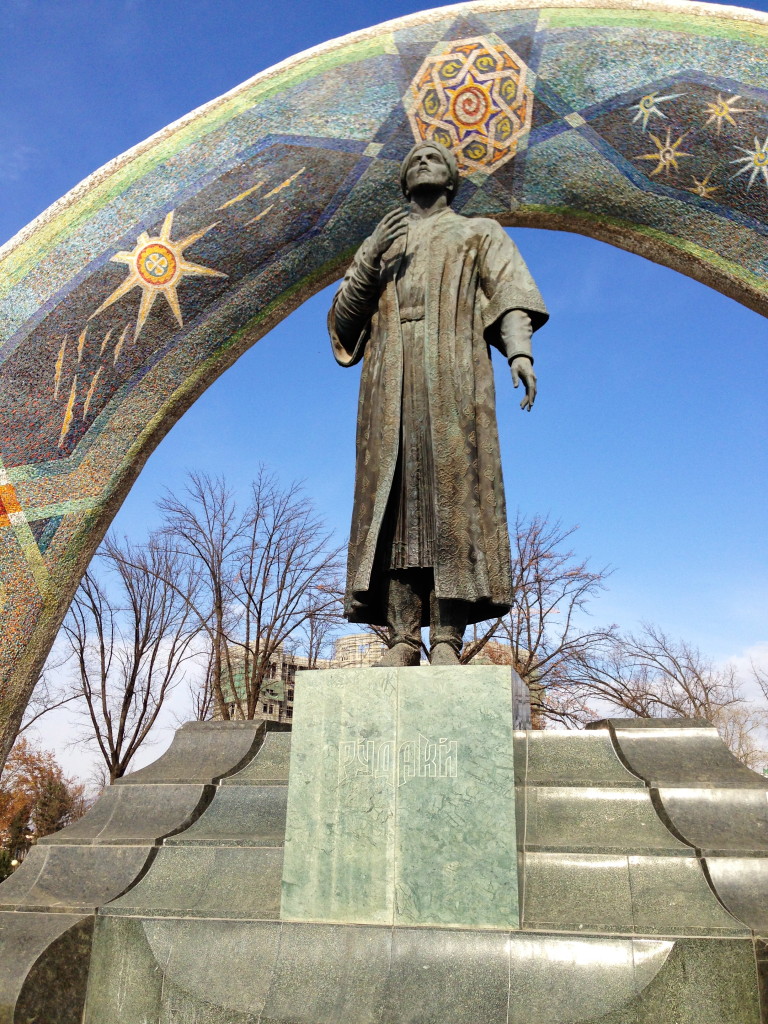Okay. I’m just going to come right out and say it. Who knew classical Persian poetry could be so fascinating??? I certainly didn’t. But that was before I learned the difference between a mathnawi and a ghazal. Before I discovered the level of importance that poetry held in medieval Persia. And certainly before I read the works of Rudaki, considered to be the Father of modern Persian verse. All in all, it’s been a wild week. So let’s dive in.
First up? A short summary of the Persian language and the technical aspects of Persian poetry. As I said last week, after the Arab invasion of Persia in the 7th century, Arabic became the dominant language for the next several centuries. However, in the 8th and 9th centuries, New Persian began to take form. This set the stage for the renaissance of the language in the 10th century, which came to be known as Classical Persian. It also quickly replaced Arabic as the dominant language in Persia. Interestingly enough, for centuries, it was believed that Persian poetry was derived from Arabic poetry. However, recently, scholars have begun to re-examine this presumption. As a result, they’ve discovered that Persian poetry actually evolved independently of Arabic poetry. It’s the only way to explain its rules, rhythms, and style.
So what exactly are those rules? For one thing, Persian poetry is all about the syllables. For example, while English poetry relies on accents and stress, Persian poetry relies on the length of its syllables. Specifically, whether these syllables are short, long, or overlong. Persian poetry is also remarkably consistent, with 99% of all known poems following just five repeating patterns and 30 common meters. The three most common types of poems are the mathnnawi, which consists of rhyming couplets, lyrical poetry, such as ghazals (love poems) and qasidas (odes), and the ruba’i, or quatrain. It is also interesting to note that Persian poetry favours these poetic forms over content variation, meaning words and rhymes often repeat themselves throughout the poems.
In addition to learning the technical aspects of Persian poetry, I also delved into the actual art of translating it. This is because unfortunately I can neither speak nor read Persian, and therefore, if I want to discover these poems for myself, I have to read translated versions. However, this presents a whole host of problems, because apparently the Persian language is constructed very differently from English. For example, Persian doesn’t have pronouns, articles, or prepositions, meaning adding in these extra words could drastically change the rhythm and pattern of a line. As a result, translations can often vary widely. Take for example the two excerpts below.
The sands of Oxus, toilsome though they be,
Beneath my feet were soft as silk to me.
Glad at the friend’s return, the Oxus deep
Up to our girths in laughing waves shall leap.
And
The sandy road by Oxus’ banks, that rugged way,
Silk-soft beneath my feet to me appears to-day:
And Jihun’s waves, for very joy at their friend’s face,
Rise to our waists in blithesome mood with fond embrace.
Believe it or not, that is the same poem. Just two different translations. Wild, right? Languages will never cease to amaze me. I also learned that the Persian language doesn’t have gendered pronouns, meaning it’s often up to the translator to make that interpretation. Once again, this can result in widely different translations. But I suppose this is the case with any translation between languages with fundamental differences in syntax.
But back to Persian poetry. When I said earlier that poetry was incredibly important in medieval Persia, I wasn’t exaggerating. Poetry was considered to be the highest form of Persian literature, and therefore the ability to write in verse wasn’t just limited to poets. Most scholars of the time often wrote in verse, and we even have medical records and journals from this time period that are written in verse as well. Being a poet was considered to be among the top influential professions in society, alongside being a civil servant, a doctor, or an astrologer. The court poet in particular was extremely important. This person was considered to be an integral part of the government, and was counted on to provide counsel and moral guidance.
“A king cannot dispense with a good poet, who shall conduce to the immortality of his name, and shall record his fame in diwāns and books. For when the king receives that command which none can escape (death), no trace will remain of his army, his treasure, and his store; but his name will endure forever by reason of the poet’s verse.”
– Nizāmi Aruzi
Which brings us (finally!) to Rudaki and why I chose to read his works for my first exploration of classical Persian poetry. Rudaki was a 10th century poet who is considered to be the father of classical Persian poetry. His primary patron was the Sāmānid Amir, Nasr ibn Ahmad II, and Rudaki was wildly successful in his position as the court poet. Reportly, Rudaki wrote over 1.3 million verses during his lifetime. 1.3 million!! Sadly, only 52 have survived to this day, meaning it is quite easy to read the entirety of Rudaki’s work. Which is exactly what I did this past week.
The longest of his surviving poems is “The Mother of Wine”, which is mainly a panegyric poem. And yes. I had to look up “panegyric” to understand that these are poems written in praise of someone or something. In this case, the Amir. And what a panegyric that poem was! Seriously. I can’t remember the last time I read such extreme purple prose. If you believe Rudaki, the Amir was a perfect and faultless God who could do no wrong. But then again, I suppose that if my entire livelihood depended on praising my boss to the heavens, I’d do the same.
Unfortunately, Rudaki sadly found himself on the wrong end of that relationship later in his life. His patron may have been the Amir, but his fortune depended on the favour of Abolfazl Mohammad ibn Abdollāh Bal’ami, vizier to the Amir. Bal’ami was known for employing poets and writers in the Persian court. In fact, he commissioned so many works, he is sometimes credited with bringing about the re-birth of Persian literature in the 10th century. Bal’ami considered Rudaki to be the finest poet of the era, and he showered him with patronage. Unfortunately for Rudaki, when Bal’ami died in 937, his favour went with him. In short order, Rudaki found himself banished from court. He died in 941, blind, desolate, and impoverished.
This dramatic turn of events is evident in his later poems, when he laments his fall from grace and spends a lot of time pondering death. He muses, “Whoever turns his back on the King’s advice, sets the foot of happiness into sorrow’s trap.” Or, “What used to be harmless now quickly harms.” And the eternal classic, “On Drunkenness”, the entirety of which reads:
Now we are drunk, so let’s drink wine.
Let’s drink from the hands of beauties.
They call us crazy and senseless.
We are not crazy. We are drunk.
In fact, Rudaki spends a lot of time, both during the good times and the bad, extolling the virtue of drinking wine and getting drunk. There is a whole poem called “The Virtues of Wine”, and an entire section of his works simply titled, “Wine poems”. Apparently Rudaki was quite the partier in his heyday. He was also not shy about his love of women, especially the concubines at court. But he was pretty terrible at adhering to their requests. Take for example the poem “Ayyar’s Message”, wherein Ayyar is his favourite concubine:
Ayyār sent a secret message to me:
“Don’t mention me in your poems so much.
This old man abuses me because of you.
I wish God would save me from his tyranny.”
Seems he didn’t get the message about leaving her out of his poems.
Questionable issues of consent aside, I loved reading Rudaki’s poems. So much so that I wish more of them had survived. His words and images are often simple in their construction, but they are also joyous, profound, bittersweet, and/or sad, depending on the poem. They feature allusions to classical Greek and Roman mythology, speak of acute devotion and intense love, and show a beautiful and unique way of looking at the world.
“The world, which had been in pain for some time, Has found a cure in this jasmine-scented wind.”
“Many a mean miser, having drunk wine,
Has spread generosity throughout the world.”
“God never closes a door on you
Before opening a hundred better doors.“
It’s sad to think about the beautiful verses he wrote that we will never be able to read today. Millions of words that can never again be heard. But even if his poetry is gone, his legacy remains. Rudaki was the first great poet of the Golden Age of classical Persian poetry. But he was far from the last. I’ll be back next week with more great poets and hopefully more great poems. In the meantime, enjoy this farewell from Rudaki.
Life was good then. Those were the days.
When my words fell on the Amir’s ears,
He gave generously, as did the others.
But times have changed, so have I. Bring me my staff.
It’s time for the cane and the beggar’s purse.
Suggestions for artists I should check out? Please contact me with your ideas. I hope you enjoyed your daily helping of art!



